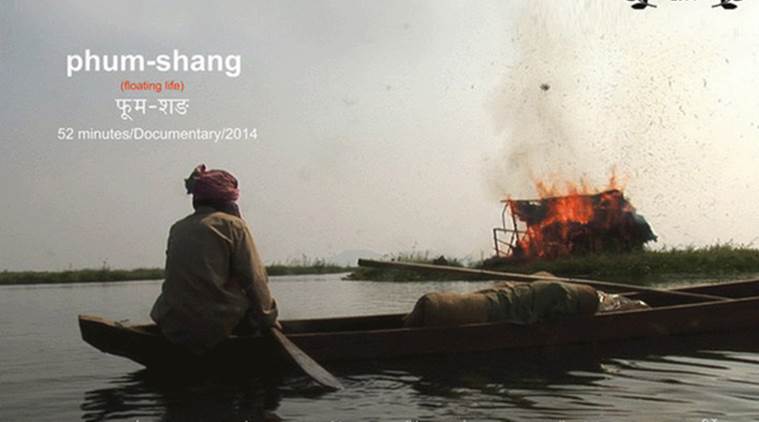Haobam Paban Kumar is a filmmaker. His documentaries and shorts are stories of the mountain terrain reality and upheavals not found in the plains. One of his first feature length documentaries, Phum Shang (A Floating Life), is about a very special fishing community. In the north-eastern Indian state of Manipur, close to its border with Myanmar, is the Loktak Lake—home to a fishing community which lives on water, amidst the graceful ambience of nature. The floating land mass, known as phumdis, are grouped together; and the lake dwellers, as always, have constructed shanties on it. The backdrop to this almost-surreal tale is the real-life intervention by the government in 2011, which saw homes destroyed and villagers forcibly evicted and left destitute. The documentary is a look into the life of this fishing community against this backdrop of displacement.

The film is one of the quietest films I’ve ever seen. This evocative use of silence makes it sound like an ode. The sound of the government’s boat-mounted mechanical diggers, destroying the homes of the lake dwellers, is a jarring assault on the, almost calm, stillness of the water. Interestingly, these mechanical diggers have been strategically kept out of the frame.
Kumar’s next, a feature film, Lady Of the Lake, does generate a fair level of curiosity in the festival circuit. But prospects outside the festival microcosm are less certain. The languid pacing reflects the pace of life of the villagers, amid the glacial sights. It is set in the same community as his documentary.
The film opens with striking shots of burning shacks, reminiscent of the shots in Phum Shang. These are from the time when government officials had invaded and destroyed the homes of the struggling fishing community, blaming them for polluting the lake. The home that Tomba shares with his wife had been spared, for the time being, but the incident had a traumatic effect on him and he became depressed by his powerlessness. The film has long shots of Tomba, sitting motionless on the empty fertiliser sack that he uses as a rug, while his wife tries to stir him out of his inertia.

Then, one day, Tomba finds a gun. Suddenly, there is a change in his natural. He is empowered by the weapon; but the change in his personality is not for the better. He becomes more adamant and confrontational. Meanwhile, his wife’s reaction to the gun is one of visceral horror. She recoils and begs him to get rid of it, saying that only bad things could come of it. Tomba resists, claiming, ‘This gun will save our souls.’
Around the same time, Tomba is disturbed on a nightly basis by the sound of someone visiting his shack. ‘It’s probably a cat,’ his wife mutters, annoyed at being woken. But Tomba clutches his gun and listens warily. The visitor, a woman in a white scarf, returns each night, like a threat.
Paban is quick to show his gratitude, saying, ‘All of my films, including Lady Of The Lake, have been made with the help of friends and former film school classmates, who have offered their time, skills and resources. Floating Life also secured funding from the Films Division of India’s Ministry of Information and Broadcasting, despite its sensitive subject matter… I see myself as a storyteller, rather than an activist, which probably helps when it comes to funding.’ He also adds, ‘There are many stories to tell about Manipur and we’ve always wanted to bring them to the outside world.’

Thanks to the emergence of digital technology, Manipur has seen a surge in film production in recent years, although many films simply attempt to fill the gap left by Bollywood, which has been banned in the state since 2000. Haobam Paban Kumar laments the lack of cinemas in Imphal. ‘We only have one now, compared to a dozen in 2000,’ he says. But he is encouraged by the recent opening of the Manipur State Film and Television Institute, headed by his former film school mentor Nilotpal Majumdar. ‘He’ll make a huge difference—he was instrumental in raising the standards of documentary filmmaking in India.’
The film somewhat reminds us of Apichatpong Weerasethakul’s blend of quaint details with a heady sense of enchantment, although this is a more low-key work on the cinematic level.
The film’s frames and imagery are very pervasive. Often, words are replaced by a string of pregnant images, poignant with meaning. The poet, Cecil D. Lewis, once said, ‘The image is one kind of soliloquy. In its movement, multiple images emerge that stir our visual impact. This visual impact is not easy to evade as it creates a kinetic power in perceivers; power of image is vastly dictated by the content. Thus, imaging a theme is the most difficult aspect of any art.’ Lady of the Lake is one film that manages to achieve this, the rightful winner of BIFFES, Bangalore, as the best films this year.
In a way, the conclusion of this fable has both a metaphor and allegory, slightly unexpected when compared to the restraint of the rest of the film. However, Kumar could have, perhaps, pushed this contrast further, with a more dramatic twist. But the closing scene makes up for the patience of the audience during the longueurs that precedes it.




